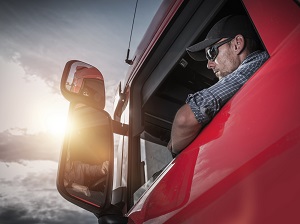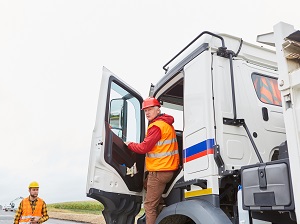A spotter may be recommended for ground guiding trucks or equipment at the job site when the driver doesn't have full view of the working area and hazards.

A spotter is recommended when:
- backing earthmoving or compacting equipment with an obstructed rearview and no back-up alarm
- backing a truck larger than a van, or any other vehicle that has large blind spots
- in congested work site areas
- visibility is poor
- near overhead power lines
- driving larger vehicles forward near overhead, side or other obstructions
- backing or driving near an excavation
- a driver requests a spotter for added safety in any situation
OSHA Standard 1926.602(a)(9)(ii) No employer shall permit earthmoving or compacting equipment which has an obstructed view to the rear to be used in reverse gear unless the equipment has in operation a reverse signal alarm distinguishable from the surrounding noise level or an employee signals that it is safe to do so.
Spotters may also be referred to as ground guides, guides, observers, or signalers.
If your job site does not have a set of spotter signals that they use consistently, consider using the signals provided by OSHA.

Spotters and drivers (or equipment operators) must work together, and both be completely focused on the task during the signaling activities.
Together, the spotter and the driver should:
- agree on hand signals before backing up
- know the driver’s blind spots
- discuss the plan for getting the driver where they need to go including positioning and planned movement of the vehicle
- survey the area surrounding the vehicle and along the path of travel for potential hazards
The spotter should be positioned in such a way that they have a clear view of the areas the driver cannot see and at the same time not be in harm’s way.
Spotters should wear high-visibility clothing, like a reflective safety vest, especially during night operations and may use flashlights to help signal when there is limited visibility or darkness.
Spotters typically use hand signals because voice signals may not be heard or can be easily misunderstood, especially if the vehicle is loud, or there is noise on the job site.

While acting as a spotter:
- Give signals to only one person, the driver.
- Use large arm and hand movements.
- Keep a safe distance from the vehicle you are guiding.
- When possible, stand to the side and rear (or front) of the vehicle (driver’s side is best).
- Avoid walking backwards while giving the signals.
- Maintain continuous visual contact with the driver.
- Do not become positioned between two moving vehicles, or between a vehicle and a fixed object.
- Stay out of the vehicle’s path of travel.
- Allow enough stopping distance and clearance.
Continue to signal even when the driver’s maneuver is the same or is proceeding normally and safely. Keep your hands up and keep the proper signal going throughout the movement.
Signaling requires your full concentration. Do not perform any other duties while you are acting as a spotter. Do not look at a cell phone, wear headphones, chat with a co-worker, or do anything else that could pose a distraction during signaling activities.

As the driver, or equipment operator, even if you use a spotter, you are still responsible for the safe operation of the vehicle. Remove all distractions, don’t look at your cellphone, turn off the radio, and focus on the spotter’s signals. Walk around the vehicle and remove any hazards.
Always keep the spotter in view. If you lose sight of the spotter, stop the vehicle immediately. Never attempt to guess what the spotter is trying to communicate. If you aren’t sure, stop the vehicle, park safely, and come to an agreement on the hand signals with the spotter.
Move the vehicle slowly and in a controlled manner. If the spotter needs to stop signaling momentarily, for any reason, stop the vehicle. Resume the maneuver only after the spotter is again fully focused and the signaling is resumed.
As a driver, if you have limited visibility or are unsure about clearance, do not move your vehicle or equipment without a spotter.

.jpeg)

.jpeg)